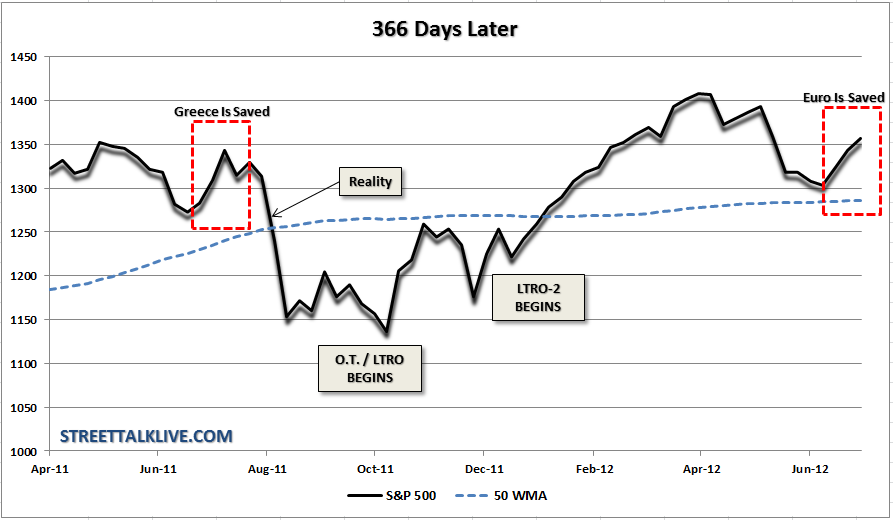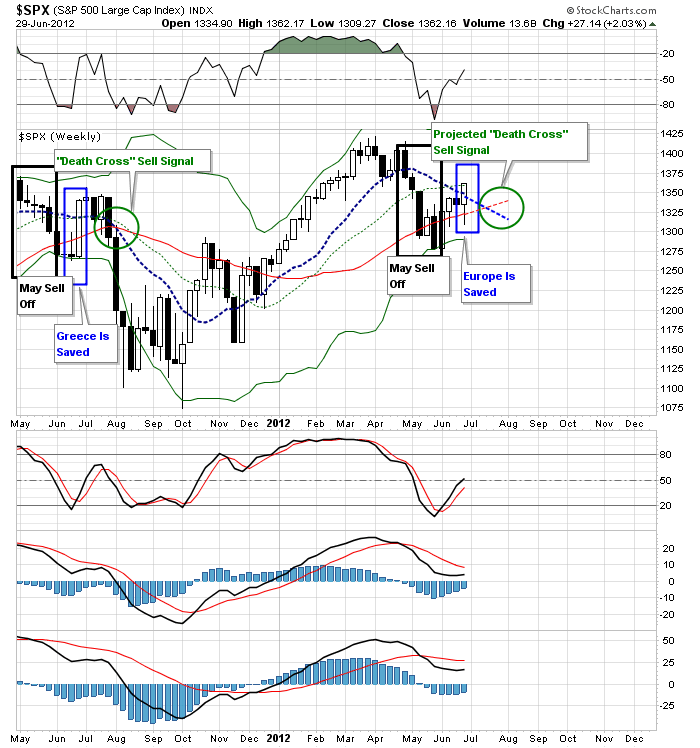Last Friday the markets surged in the biggest short covering rally of the year, combined with quarter end ”window dressing” for mutual funds, on news from the EU meeting that a “bailout” agreement had been reached. As the media remained busy fawning all over themselves trying to analyze each and every nuance of the rally; there were some not so unimportant details which were overlooked. However, before we get into the details of what happened in Europe and the potential impacts to our market analysis, I thought it would be important to bring you this tidbit of reality:
“Blue-chip stocks posted the biggest gain in more than two months as signs of progress in Greece’s debt crisis sparked a broad market rally” – WSJ, June 28, 2011.
That’s right; it was just one year and one day ago that the market surged on signs of“progress” to resolve the crisis in the Eurozone. This just goes to show how little progress has been made while the market yanks investors from one headline to the next.

How did the June 28th surge work out for investors last year? Including that session through July 1st that DJIA ran up 539 points or 4.5%.
It was at this point that the media was in full “bull” mode parading one analyst and fund manager after another across the set to convince investors to plug their money back into the markets.
We stated that following weekend: “Last week it was all about ‘fear’ – as the market plunged to the 200 day moving average investors were lining up to sell their holdings. Today, it is all about ‘greed’ and after a nice pop off of the bottom investors can’t wait to buy back in. I am not saying that the rally this week doesn’t change things. It may, but only time will tell. However, I doubt it is the case.”
By early August the market had dropped almost 1200 points or 9.5%.
A “Remedy” For The Euro Crisis?
On Friday morning we woke up to the news that the EU meeting had come to a resolution to“bailout” Spanish and Italian banks. This is good from the standpoint that it may temporarily delay a “Lehman” type event in the Eurozone. Here are the details from the meetings release:
- There was an “affirmation” of an imperative need to “break the vicious circle between banks and sovereigns.” If fact, this need is SO IMPERATIVE they are going to get right on it by the END OF 2012. I am sure nothing will go wrong between now and then.
- “When an effective single supervisory mechanism is established, involving the ECB, for banks in the euro area the ESM could, following a regular decision, have the possibility to recapitalize banks directly.” This is all fine and dandy but the ESM is not ratified or funded as of yet, and as of this morning, Findland and Holland are just saying “NO” to bank bailouts.
- “We reaffirm that the financial assistance will be provided by the EFSF until the ESM becomes available, and that it will then be transferred to the ESM, without gaining seniority status.” Refer to point #2.
- “We affirm our strong commitment to do what is necessary to ensure the financial stability of the euro area, in particular by using the existing EFSF/ESM instruments in a flexible and efficient manner in order to stabilize markets for Member States respecting their Country Specific Recommendations and their other commitments including their respective timelines, under the European Semester, the Stability and Growth Pact and the Macroeconomic Imbalances Procedure.” This is the 187th affirmation of committment to save the Euro, a rough guess, but talk is cheap.
It’s All Just Shampoo Directions
It is important to understand that the “agreement” reached last week was nothing more than political posturing and is, as usual, long on hope and short on details. Going into the summit meeting there was no clear and coordinated plan to solve the issues that plague the Eurozone. Coming out of the summit meeting there is still no clear and coordinated plan to solve the issues that plague the Eurozone. As with all things Euro, the details are left to later. This is a primary reason why the whole scheme of the monetary union was flawed from the outset. Once the single currency had been established the Eurozone leaders lost interest in getting the “details” worked out to make it a successful venture. The problem is that each of these summit meetings turn out to be shampoo directions: Wash, Rinse and Repeat. Sooner or later the bottle is empty.
The biggest issue comes from funding capability. The initial loans, ideally to bail out Spanish banks, must come from the EFSF which, as we have stated previously, only has about €200 Billion of funding capacity. However, therein lays the rub - where is the money going to come from?
As I have stated many times before, the European Stability Mechanism (ESM), which everyone currently sees as the savior for the EU, does NOT exist yet as only four out of the required 17 countries have ratified its legislation. Furthermore, the due date for the ratification is July 9th – There is a very low probability that ratification is completed by then.
Secondly, the ESM, if it ultimately ratified, will have a size of €500 Billion of which Spain and Italy will contribute 30% of its funding. Does anyone other than me see the irony of the ESM “bailout” fund which must be used to save Spain and Italy receiving 1/3 of its funding from the countries it is going to bail out? You really can’t make this stuff up.
Third, Spain needs a €100 Billion right now but is a €2 Trillion issue. Greece is going to be on deck shortly for another €100 Billion or so. Italy is going to need a bailout very soon of €200 Billion or more and France is not far off in the distance. The ESM, in its current form, is woefully insufficient to do much more than to temporarily stave off a financial crisis. The fact the EU leaders didn’t agree to increase the EFSF or the ESM is a clear and ringing endorsement of the simple truth that no one has the funds to commit to bailing out everyone else.
For months we have been writing missives on the fact that this is a death spiral for the Eurozone. Europe is out of buyers. Europe is out of money. Europe is out of time.
One of the key points from the recent EU meeting is that the ECB will now be using“bailout” funds to help recapitalize EU banks. This move will ultimately end up hurting the banks that seek funding from the ECB just as it did to those that drew on the ECB’s LTRO1 and LTRO 2 schemes. Those banks quickly found themselves being severely punished in the credit and bond markets. After all, requesting aid is essentially a public admission that one’s bank is in major trouble. In this end this hurts the bank seeking aid as everyone now knows that it’s on the ropes. Duh!
Tick…Tick…Tick. While the markets surged on Friday on the idea that “Europe is now saved…” the reality is that NONE OF THIS will go into effect until December. What are the odds that Spain, Italy, Greece, Portugal, Cyprus and France won’t need funding before then!
Germany – Still The Lynch Pin
There were many statements made in recent days that Angela Merkel had “blinked” and finally caved to pressures of the other members of the EU. I find this hardly to be the case.
First of all, Mrs. Merkel’s comments that “countries must fulfill conditions for bond-buying programs that Troika must check” suggests the agreement on how to implement the conclusions reached is not as strong as headlines initially suggested.
As she stated: “First we agreed that if countries need the instruments to buy bonds on the primary or secondary market from the EFSF or ESM then the conditionality will be agreed as follows:
The country report will be presented to the Commission on which basis we will agree a memorandum of understanding in which there will be a time-frame. The EU/IMF ‘troika’ will then supervise, as it is always usual in the EFSF and ESM, whether the conditions are met.
That would be the case if Spain or Italy, with regards to their interest burden, make use of such instruments. Then this conditionality would apply, which we have agreed on precisely, according to the rules we have.”
Furthermore, both Schaeuble and Merkel have already made it abundantly clear that there will NO Euro Bonds in their lifetimes. This is a major wrinkle in the ability for the Euro to survive long term. As we have stated many times in the past – the only ability for the Euro to survive is to become a Constitutional Union, like the U.S., where there is one Central Bank and Leadership for the whole of the Euro. The ability to issue Euro Bonds is crucial to consistently have the funding capability necessary to meet regular funding requirements during periods of recessions and financial stress.
Chancellor Merkel’s demands for conditions on direct bank recapitalization means that there will be more standoffs in the future further delaying the process. The climate of acceptance for bailing out others is deteriorating rapidly in Germany, and while Parliament is going along with the very loose agreement right now, there is a strong possibility they will reverse course when it comes down to actually doing it.
Finally, for Germany, it is not entirely up to Merkel. Lawsuits are already being filed in the German courts which will likely force a “referendum” vote. Merkel may have “blinked”simply because she knew that any such action would result in a referendum that would ultimately lead to a defeat any potential bailout mechanism. Such a defeat by a referendum would finally let Merkel “off the hook” of being the only face of opposition to the Eurozone.
No Change To Outlook
First, liquidity injections, while the announcements are full of good intentions, do not in fact change anything regarding the solvency of banks today. Furthermore, while the announcement address funding issues they do not in any way address the problems of growth surrounding a Europe mired in recession.
The only thing that is trying to be changed in who actually foots the bill for the solvency of banks? However, with broke countries required to fund their own bailouts seems a bit of a lost cause already.
A healthy dose cynicism is probably best taken at this point. While the announcement was certainly enough to wake up the “shorts” on Friday the normalization of economies in Europe has not been addressed. The “economic effectiveness” of liquidity injections is, as we have witnessed in the U.S., is low to none. While the media is viewing the latest announcements out of the EU Summit as game-changers – they simply are not.
- No one in the EU actually has the money to make the measures work – again, Spain and Italy are 30% of the ESM and Spain, who will get their initial funding from the EFSF, owes roughly €90 billion to fund its own bailout.
- Bond markets will stage a knee jerk reaction to the announcement, as short covering takes place, pushing prices up and yields down. This will be short lived.
- None of these decisions address any of the major issues facing the Eurozone, or its banking system, which are insolvency and excessive leverage.
- These announcements are more political posturing rather than real solutions. Europe needs capital NOT politics at this point.
The question is really what is going to happen next? With all of our sell signals in place and our “major sell” signal approaching – it is prudent to remain cautious until something changes.

No comments:
Post a Comment